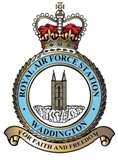RAF Waddington
| RAF Waddington | |||||||
|---|---|---|---|---|---|---|---|
| Near Waddington, Lincolnshire in England | |||||||
|
E-3D Sentry Aircraft Lands at RAF Waddington | |||||||
|
"Your Faith and Freedom" | |||||||
 EGXW Shown within Lincolnshire | |||||||
| Coordinates | 53°10′21″N 000°31′51″W / 53.17250°N 0.53083°WCoordinates: 53°10′21″N 000°31′51″W / 53.17250°N 0.53083°W | ||||||
| Type | Royal Air Force station | ||||||
| Site information | |||||||
| Owner | Ministry of Defence | ||||||
| Operator | Royal Air Force | ||||||
| Website |
www | ||||||
| Site history | |||||||
| Built | 1916 | ||||||
| In use |
1916–1920 1937–present | ||||||
| Garrison information | |||||||
| Current commander | Group Captain R P Barrow OBE RAF | ||||||
| Occupants |
| ||||||
| Airfield information | |||||||
| Identifiers | IATA: WTN, ICAO: EGXW | ||||||
| Elevation | 70 metres (230 ft) AMSL | ||||||
| |||||||
Royal Air Force Waddington or more simply RAF Waddington (IATA: WTN, ICAO: EGXW) is a Royal Air Force station located 4.2 miles (6.8 km) south of Lincoln, Lincolnshire and 13.3 miles (21.4 km) north east of Newark-on-Trent, Nottinghamshire, England. The site is owned by the Ministry of Defence and managed by the RAF.[1]
The station badge depicts Lincoln Cathedral rising through the clouds.[2]
History
First World War
Waddington opened as a Royal Flying Corps flying training station in 1916, they taught many pilots, including members of the American army, teaching students to fly a variety of aircraft and was transferred to the Royal Air Force on 1 April 1918 operating until 1920, when the station went into care and maintenance.[2]
Squadrons operating during this time:
- No. 82 Squadron RFC between 30 March 1917 and 17 November 1917 using the AW FK 8 before moving to St Omer.[3]
- No. 97 Squadron RFC between 1 December 1917 and 21 January 1918 with no aircraft before moving to Stonehenge.[4]
- No. 105 Squadron RFC formed at the airfield on 23 September 1917 flying various aircraft and stayed until 3 October 1917 when it moved to Andover.[5]
- No. 117 Squadron RFC formed at Waddington on 1 January 1918 flying various aircraft and stayed until 3 April 1918 when the squadron moved to Hucknall.[6]
- No. 123 Squadron RFC formed at the airfield on 1 February 1918 and flew various aircraft before moving to Duxford on 1 March 1918.[7]
- No. 23 Squadron RAF between 15 March 1919 and 31 December 1919 with no aircraft before being disbanded.[8]
- No. 203 Squadron RAF between 27 March 1919 and December 1919 with no aircraft as a cadre before moving to Scopwick.[9]
- No. 204 Squadron RAF from 11 February 1919 as a cadre with no aircraft until 31 December 1919 when the squadron disbanded.[9]
Inter war period
As part of the pre-war expansion programme the Waddington site was earmarked for development into a fully equipped Bomber Station. As it developed, RAF Waddington made an increasingly dramatic imposition on the surrounding rural landscape[1] such as to the Lincolnshire Edge, a Jurassic limestone ridge, which forms the distinctive backbone of the county from Whitton on the Humber Estuary in the north, down to Grantham in the south.[1] Along the top of the Edge a series of airfields were developed, including RAF Waddington, RAF Cranwell and RAF Scampton.[1] They lie within an open landscape, consisting of rectilinear fields and few boundaries.[1]
Waddington reopened as a bomber base on 12 March 1937,[2] with 50 Squadron (50 Sqn) arriving on the same day with their Hawker Hinds and then adding the Handley Page Hampden.[10] 110 Squadron (110 Sqn) arrived 15 days later initially with the Hind before switching to the Bristol Blenheim I.[11] On 7 June 1937 88 Squadron (88 Sqn) reformed at Waddington with the Hind before moving to RAF Boscombe Down on 17 July 1937.[12] On 16 June 1937 44 Squadron (44 Sqn) moved in from RAF Andover flying the Blenheim I before switching to the Avro Anson I and the Hampden in February 1939.[13] In May 1939 110 Sqn left going to RAF Wattisham[11] and 50 Sqn left the following year being moved to RAF Lindholme.[10]
Second World War
.jpg)
RAF Waddington began the war housing the Hampdens of 44 Sqn and 50 Sqn. Both squadrons were in action on the same day as Britain's war declaration, attacking German naval targets at Kiel.[2][14] Waddington squadrons were also involved during the critical stages of the late summer and early autumn of 1940, attacking barges in the channel ports which were being assembled as part of the invasion fleet.[2]
In November 1940 it was the first station to receive the Avro Manchester heavy bomber.[15]
No. 44 Squadron RAF was the first in RAF Bomber Command to fly operationally with the Avro Lancaster on 2 March 1942 from Waddington.[15] BT308, the first prototype Lancaster (or Mk III Manchester), arrived at Waddington in September 1941 for flight tests. Similar to RAF Scampton, the station was part of 5 Group.
44 Sqn left on 31 May 1943 going to RAF Dunholme Lodge.[13]
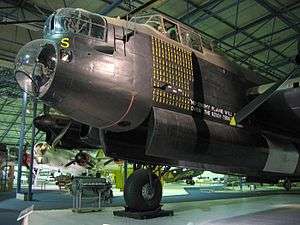
Squadrons operating during this time:
- 97 Sqn reformed here on 25 February 1941 with the Avro Manchester before moving to RAF Coningsby on 10 March 1941.[4]
- 9 Sqn joined the airfield on 7 August 1942 initially with the Vickers Wellington III before switching to the Lancaster I and III during September 1942. The squadron moved to RAF Bardney on 14 April 1943.[17]
- 142 Sqn between 15 June 1940 and 3 July 1940 with the Fairey Battle before moving to RAF Binbrook.[18]
- 207 Sqn reformed at Waddington on 1 November 1940 with the Manchester adding the Hampden for a month in July 41. The squadron moved to RAF Bottesford on 17 November 1941[19]
- 420 Sqn RCAF formed here on 19 December 1941 with the Hampden before moving to RAF Skipton-on-Swale on 7 August 1942.[20]
- 463 Sqn RAAF formed at the airfield on 25 November 1943 with the Lancaster Mks I and III before moving to RAF Skellingthorpe on 3 July 1945.[21]
- 467 Sqn RAAF between 13 November 1943 and 15 June 1945 with the Lancaster Mks I and III. The squadron then moved to RAF Metheringham.[21]
- 617 Sqn between 17 June 1945 and 19 January 1946 with the Lancaster Mk VII-FE before moving to RAF Digri.[22]
Cold War
In the Cold War, RAF Waddington became an Avro Vulcan V-bomber base, with 83 Sqn being the first in the RAF to receive the Vulcan in May 1957. It continued in this role until 1984 when the last Vulcan squadron, No. 50, disbanded. From 1968, the UK nuclear deterrent was transferred to Polaris submarines, starting with HMS Resolution.
In August 1960, the station developed the sudsmobile technique to lay a 1,000 yd × 30 yd (914 m × 27 m) carpet of foam in around a half-hour for a wheels-up landing. Previously it had taken around three hours to lay a foam carpet on the runway. A Canberra from RAF Wyton landed wheels-up on 23 August 1960, with a Victor managing the same on 5 December 1960.[23]
The fiftieth anniversary of the RAF was celebrated at the base on 1 April 1968, mainly because the RAF's last flying Lancaster was based at the airfield from the mid-1960s until 1970, when moved temporarily to Hendon.

Squadrons operating during this time:
- No. IX Squadron RAF operating the Avro Vulcan B.2 between 1975 and April 1982 when they were disbanded, later reforming at RAF Honington as the first operational Panavia Tornado GR.1 squadron.
- No. 12 Squadron RAF between 26 July 1946 and 18 September 1946 initially with the Lancaster Mk I and III before swapping to the Avro Lincoln B.2 and moving to RAF Binbrook.[24]
- No. 21 Squadron RAF from 26 May 1955 until 31 December 1957 with the English Electric Canberra B.2 before being disbanded[25] also No. 27 Squadron RAF which both joined and departed RAF Waddington on the same days as 21 Sqn. The squadron also operatied the Canberra B.2 and was disbanded on 31 December 1957.[26]
- No. 44 Squadron RAF between 10 August 1960 and 21 December 1982 when they were disbanded. The squadron operated the Avro Vulcan B.1 and B.2.[13]
- No. 50 Squadron RAF were based at Waddington from 26 January 1946 with the Lincoln B.2 before being disbanded on 31 January 1951.[10]
- No. 50 Squadron RAF reformed at the airfield on 1 August 1962 and operated the Vulcan Mks B.1, B.2 and B.2K before being disbanded on 31 March 1984.[10]
- No. 57 Squadron RAF between 7 October 1946 and 4 April 1951 with the Lincoln B.2 before moving to RAF Marham, the squadron returned on 4 June 1951 with the Washington B Mk 1 before leaving again on 2 April 1952 to RAF Coningsby.[27]
- No. 61 Squadron RAF starting from 25 January 1946 with the Lancaster Mks I and III before being replaced by the Lincoln B.2. The squadron left on 6 August 1953 moving to Wittering.[28]
- No. 83 Squadron RAF from 21 March 1957 with the Vulcan B.1 before being reduced to a cadre with no aircraft and moving to RAF Scampton on 10 August 1960.[3]
- No. 101 Squadron RAF from 26 June 1961 with the Vulcan B.1 and B.2 before being disbanded on 4 August 1982.[5]
Falklands War

Operation Black Buck involved aircraft (three) and crews from the base (44 Sqn, 50 Sqn and 101 Sqn) for a bombing raid on Port Stanley airfield. The three Vulcan B2s were twenty-two years old, and were selected for their more powerful Olympus 301 engines. The complicated refuelling plan (14 Victor tankers) was only contemplated due to the belief of Sir Mike Beetham, then Chief of the Air Staff, who had developed the RAF's in-flight refueling capability with Vickers Valiants with 214 Sqn at RAF Marham in 1959. Spare parts for the operation were requisitioned from scrapyards in Newark-on-Trent and military museums. Navigation came from the Delco Carousel inertial navigation system, never used previously by the RAF. 44 Squadron left on 21 December 1982.[13] The K2 Victor tanker aircraft came from 55 Sqn and 57 Sqn at RAF Marham. Later during 1982, there was a female peace camp outside the base for five months. At the beginning of 1982, the base had been designated to be closed, when the Vulcans would have left.
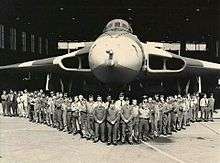
Tactical Fighter Meet 86 was held at the base in August 1986, which used RAF Spadeadam as a practice target.
Airborne early warning
In the mid-1980s the base became home to a few NATO AWACS aircraft operating from their main base (with eighteen AWACS planes) at NATO Air Base Geilenkirchen in North Rhine-Westphalia on the Germany-Dutch border. The RAF used these aircraft until it had bought its own AWACS fleet, which were due to enter service in 1991.
During the 1991 Gulf War, American casualties were ferried through the base to the USAF Nocton Hall military hospital. The Electronic Warfare Operational Support Element (EWOSE - now known as the Air Warfare Centre) moved from RAF Wyton to Waddington in March 1995.
Previous Units
The following units were stationed at Waddington at some point:[29]
- No. 1 Aircraft Storage Unit RAF
- No. 3 Group Practice Flight RAF
- No. 6 Blind Approach Training Flight RAF
- No. 9 Conversion Flight RAF
- 11th Aero Squadron
- No. 23 Squadron RAF
- No. 26 Squadron RAF Regiment
- 27th (Training) Wing RAF
- No. 44 Conversion Flight RAF
- No. 53 Base RAF
- 135th Aero Squadron
- No. 230 Operational Conversion Unit RAF
- No. 420 Conversion Flight RAF
- No. 1506 (Beam Approach Training) Flight RAF
- No. 1661 Heavy Conversion Unit RAF
- No. 2956 Squadron RAF Regiment
- Air Transport and Air-to-Air Refuelling Operational Evaluation Unit
- DB-7 Flight
- Electronic Warfare Detachment
- Electronic Warfare Operational Support Establishment
- Ferrying Flight
- Lincoln Conversion Flight
- Lincoln Reserve Holding Unit
- Nimrod AEW Joint Trials Unit
- Sentry Maintenance Squadron
- Sentry Operational Evaluation Unit
- Sentry Standards Unit
- Sentry Training Sqn
- Vulcan Display Flight
Present day
The base is the RAF’s Intelligence Surveillance Target Acquisition and Reconnaissance (ISTAR) hub and is home to a fleet of aircraft composed of Sentry AEW1, Sentinel R1, Shadow R1, RC-135W Rivet Joint and operating base for the RAF's MQ-9 Reaper. The station is also home to No. 34 Expeditionary Air Wing.
There is an outdoor viewing area east of the A15 road close to the northern end of the long runway which was designed to accommodate V bombers. Short-term visits from different NATO and Swiss fighter squadrons, in the past, used to generate occasional additional noise and interest because the airfield was conveniently placed for offshore practice firing ranges above the North Sea. However, with the closure of the aforementioned Air Combat Manoeuvring Instrumentation range these visits have ceased. Waddington also has a very active Force Development ethos, putting emphasis on the development of its busy personnel.
No. 34 Expeditionary Air Wing was formed at Waddington on 1 April 2006 encompassing most of the non-formed unit personnel on station. The EAW does not include the flying units at the station. The station commander is dual-hatted as the commander of the wing.
Amateur Radio licensees are not allowed to operate unattended radio beacon transmitters on 28.000 - 29.700 MHz, 10.000 - 10.125 GHz, 24.000 - 24.050 GHz or 47.000 - 47.200 GHz within 50 km of the Waddington airfield, centred on Ordnance Survey Grid Reference SK 985640.[30]
The Lincolnshire & Nottinghamshire Air Ambulance, now flying a AgustaWestland AW169 (previously a MD-902 Explorer), began operating from the base in 1994, and continues to be based on station, providing a Helicopter Emergency Medical Service to the Lincolnshire and Nottinghamshire public.[31]
RAF Waddington Voluntary Band is one of seven voluntary bands within the RAF and is proud to serve the station and the surrounding areas. Members of the band include RAF personnel as a second duty, dependants, civil servants and local civilians. As part of the station's musical heritage, Pink Floyd performed at the station's Raven Club on 20 April 1968.
All of the aircraft operating squadrons based at RAF Waddington were dispersed to other airfields in July 2014 when the runway was closed for rebuilding.[32] The project, rated at £35 million and due to take 12 months, actually ran over to 26 months and re-opened to aircraft officially in November 2016. The work is expected to increase the operational capability of the runway and airfield by 25 years.[33]
Current units

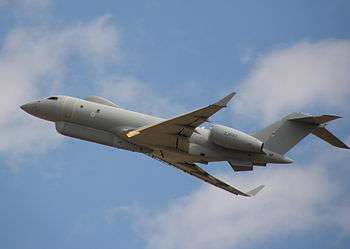
Current flying and major non-flying units based at RAF Waddington.[34][35]
Royal Air Force
- No. 5 (Army Co-operation) Squadron - Sentinel R1
- No. 8 Squadron - Sentry AEW1
- No. 13 Squadron - MQ-9 Reaper
- No. 14 Squadron - Shadow R1
- No. 39 Squadron - MQ-9 Reaper.
- No. 51 Squadron - RC-135W Airseeker
- No. 54 (Reserve) Squadron - Intelligence Surveillance, Target Acquisition and Reconnaissance (ISTAR) Operational Conversion Unit (OCU)
No. 2 Group (Air Combat Support) RAF
- HQ Intelligence Reserves
- No. 7006 (VR) Intelligence Squadron (Royal Auxiliary Air Force)
- No. 7010 (VR) Photographic Interpretation Squadron (Royal Auxiliary Air Force)
- No. 7630 (VR) Intelligence Squadron (Royal Auxiliary Air Force)
- Air Intelligence Centre
- HQ Air Warfare Centre
- Joint Electronic Warfare Operational Support Centre
- No. 56 (Reserve) Squadron - ISTAR Operational Evaluation Unit (OEU)
- No. 92 (Reserve) Tactics and Training Squadron[37]
Other RAF Units
- Air Battlespace Training Centre
- E-3D Software Support Team (SST)
- RAF Waddington Voluntary Band
The deployable elements of the station structure form the core of No. 34 Expeditionary Air Wing.[31]
British Army
Royal Engineers (8 Engineer Brigade, 12 (Force Support) Engineer Group)
- 20 Works Group Royal Engineers (Air Support)
- 531 Specialist Team Royal Engineers (Airfields) (STRE)[38]
Civilian
- Lincolnshire & Nottinghamshire Air Ambulance - AgustaWestland AW169.[39]
- RAF Waddington Flying Club - Cessna 152, Cessna 172 and PA-28.[40]
RAF Waddington VC recipients
Squadron Leader John Nettleton
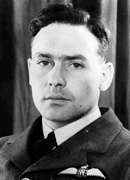
On 17 April 1942, Squadron Leader John Nettleton was the leader of one of two formations of six Avro Lancasters from 44 Sqn detailed to deliver a low-level attack in daylight on the diesel engine factory at Augsburg in Southern Germany. The enterprise was daring, the target being of high military importance. To reach it and get back, some 1,000 miles had to be flown over hostile territory.
Soon after crossing into enemy territory his formation was engaged by 25 to 30 fighters. A running fight ensued, one by one the aircraft of his formation were shot down until in the end only his own and one other remained. The fighters were shaken off but the target was still far distant. With great spirit and almost defenceless, he held his two remaining aircraft on their perilous course and after a long and arduous flight, mostly at only 50 feet above the ground, he brought them to Augsburg. Here anti-aircraft fire of great intensity and accuracy was encountered. The two aircraft came low over the roof tops. Though fired at from point blank range, they stayed the course to drop their bombs true on the target. The second aircraft, hit by flak, burst into flames and crash-landed. The leading aircraft, though riddled with holes, flew safely back to base, the only one of the six to return.
Gate guardian
The gate guardian at RAF Waddington is Avro Vulcan XM607, one of three Vulcan bombers (XM597, XM598, XM607) which took part in Operation Black Buck raids between April–June 1982. XM607 was stationed at RAF Waddington at the time of the Falklands War and took part in the raids, captained by pilots Flight Lieutenant Martin Withers DFC (on mission 1 and 7) and by Squadron Leader John Reeve (on mission 2).[41] In 1984, along with all other remaining Vulcans, XM607 was retired from active service, and was preserved as the gate guardian at RAF Waddington.[41] In 1993 the only RAF Avro Vulcan bomber maintained by RAF Waddington for flying displays, serialled XH558, was retired due to budget restraints to Bruntingthorpe Aerodrome, Leicestershire. This aircraft returned to display flying following refurbishment and was the only airworthy Avro Vulcan example, operated by the Vulcan to the Sky Trust as a display aircraft, before retiring from flight in October 2015.
Former Station Commanders

- Group Captain Charles Elworthy 1943-1944
- Air Cdre Hugh Connolly CB DFC 1955-1956
- AVM Arthur Griffiths CB 1967-1969
- AVM Charles Maughan CB CBE
- AVM Hubert Hall CB CBE 1971-1973
- AVM Sir Richard Peirse CB 1973
- AVM Michael Pilkington CB CBE 1979-1981
- Group Captain J. Laycock BA RAF 1981-1982
- Air Cdre J.L. Uprichard CBE RAF 1983
- Group Captain M.J. Remlinger RAF 1995-1996
- Group Captain Richard Powell OBE MBA MA MCMI RAF 2009-2010
- Group Captain Chris Jones ADC MA RAF 2010-2011
- Group Captain Al Gillespie ADC MA BSc RAF 2011-2013
- Air Cdre Al Gillespie ADC MA BSc RAF 01 Nov 13 - 16 Nov 13
Waddington International Air Show
| Waddington International Air Show | |
|---|---|
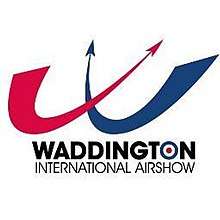 | |
| Status | Defunct |
| Genre | Air show |
| Dates | July |
| Frequency | Annual |
| Venue | RAF Waddington |
| Country | United Kingdom |
| Established | 1995 |
| Attendance | 140,000 |
Inauguration in 1995
The first RAF Waddington International Air Show was staged at RAF Waddington in 1995, after the event was moved down from RAF Finningley - an RAF station located east of Doncaster (now Robin Hood Airport Doncaster Sheffield) which was closed down in 1995. Over the following years the RAF Waddington International Air Show developed into the largest of all Royal Air Force air shows. It took place on the first weekend in July, attracting over 140,000 visitors and representatives of Air Forces from all round the world. The main purpose of the show was to raise public awareness and understanding of the RAF and its role today. Eighty five percent (85%) of all proceeds from the event were distributed to the two main Service charities; the RAF Benevolent Fund and the RAF Association; the remaining 15% donated to local worthy causes. Since the inaugural year 1995 the Air Show has raised over £2,700,000 for Service and local charities.
2010

The 2010 Air Show took place over the weekend of 3 and 4 July. The main themes being 90 years since the first ever RAF air show, at RAF Hendon, 70th anniversary of the Battle of Britain and 35 years of Airborne Early Warning. The flying display included Vulcan XH558, many regular exhibitors and aircraft but also display teams that had never been to Waddington before, including the Turkish Stars and the Czech Saab JAS 39 Gripen and Alca L-159 display.
2011
The 2011 Air Show took place on 2 and 3 July, with the theme of Air Power - Past, Present and Future. Several indoor and outdoor exhibitions reflected this theme, including a new audio-visual experience in the main exhibition hangar. Visitors learned about the RAF's current operations abroad, the RAF's equipment and the RAF's personnel, devoted to their roles within the Royal Air Force. The USAF Display Team, The Thunderbirds, also took part. Displays included the Red Arrows, Team Viper, Belgian F16 solo, Avro Vulcan XH558 and the Royal Jordanian Falcons as well as many others.
Ground displays included over 100 aircraft, 250 trade stands, two exhibition hangars and the Military Village concept where all services display, the Waddington SERE (Survive, Evade, Resist, Extract) School display with its close RNLI association. Many clubs also featured in the Village demonstrating the diversity of hobbies and interests available to RAF personnel today.
2012
The 2012 (30 June/ 1 July 2012) airshow attracted over 130,000 visitors to RAF Waddington from across the UK and beyond. Celebrating 100 years of the Central Flying School, Combat ISTAR and the Year of Lincolnshire Aviation the airshow had over 210 aircraft on display. Twenty countries took part in the event, with the first appearance in the UK by a RAAF Boeing Wedgetail and the debut appearance in Europe by the Republic of Korea Black Eagles display team. The team took the best flying display award.
2013

The 2013 airshow was held over 6 and 7 July 2013 at RAF Waddington and celebrated the 95th Anniversary of the Royal Air Force. The airshow also commemorated 70yrs since the historic and daring raids on the German dams of WW2, the 100th Anniversary of RAF Waddington's own 5(AC) Squadron and looked into the secretive world of ISTAR. Over 150,000 visitors attended the show in 2013, making it the biggest and best attended military airshow in the UK. The show featured the only display in the UK by the Turkish Air Forces Solo Türk F-16 demo as well as participation from the Netherlands, Belgium, Poland, France, Italy, Jordan, Czech Republic and many more. The show also featured the Saab 37 Viggen.
2014
The RAF Waddington Airshow of 2014 was also widely regarded as a success. Crowds in excess of 135,000 flocked to the base over the two days of the show helping to generate a sum of £260,000 which was in turn donated to Service and local charities.[42] However 2014 was to prove to be the last time an airshow would be staged at RAF Waddington.[43]
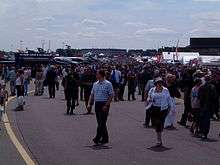
The base was earmarked for development, a significant part of which being concerned with the station's runway with work scheduled for 59 weeks. This therefore ruled out an airshow during 2015.
The timing of the works coincided with a review of the base in general, the continuance of the airshow being also part of the review. The outcome was that having weighed up the content of the report, it was decided that: "significant security risks as well as certain operational risks" resulted from the operation of the RAF Waddington Airshow, and therefore the airshow, for the reasons cited, would not be continued with.[43] These security risks have generally centred around RAF Waddington being used as a base for the operation of Reaper drones.[44]
There was strong public objection to the decision regarding the event. A petition numbering 4,262 signatories was gathered with local politicians also campaigning for the retention of the airshow.
In February 2016 it was announced that following an agreement between the Royal Air Force and the Royal Air Force Charitable Trust, the venue of the airshow would switch from RAF Waddington to RAF Scampton, with the hope that the airshow will be resurrected in 2017.[43]
In popular culture
In 2002, the half-hour ITV programme Airbase documented life at the airfield. Elizabeth Simmonds, the Olympic swimmer, trained at the base's pool.
See also
- List of Royal Air Force stations
- List of AWACS aircraft operators
- List of V Bomber dispersal bases
- List of surviving Avro Lancasters
References
Citations
- 1 2 3 4 5 http://lincolnshire.moderngov.co.uk/mgAi.aspx?ID=1891
- 1 2 3 4 5 "RAF Waddington Beginnings". Royal Air Force (RAF). Retrieved 19 October 2008.
- 1 2 Jefford 1988, p. 50.
- 1 2 Jefford 1988, p. 53.
- 1 2 Jefford 1988, p. 54.
- ↑ Jefford 1988, p. 57.
- ↑ Jefford 1988, p. 58.
- ↑ Jefford 1988, p. 32.
- 1 2 Jefford 1988, p. 68.
- 1 2 3 4 Jefford 1988, p. 41.
- 1 2 Jefford 1988, p. 55.
- ↑ Jefford 1988, p. 51.
- 1 2 3 4 Jefford 1988, p. 39.
- ↑ Gooch, Sam (30 January 2015). Bombers: 44 and 420 Squadrons. Group Captain John 'Joe' Collier DSO, DFC and Bar. Pen and Sword Books. p. 37. Retrieved 9 June 2016.
- 1 2 "Bomber Command No.207 Squadron". Royal Air Force. Retrieved 9 June 2016.
- 1 2 "AVRO Lancaster B.Mk.1 R5868/7325M Museum Accession Number 74/A/12" (PDF). RAF Museum. 2015. Retrieved 9 June 2016.
- ↑ Jefford 1988, p. 27.
- ↑ Jefford 1988, p. 61.
- ↑ Jefford 1988, p. 69.
- ↑ Jefford 1988, p. 91.
- 1 2 Jefford 1988, p. 94.
- ↑ Jefford 1988, p. 101.
- ↑ "Flight - 16 December 1960 - In Brief". Flightglobal.com. Retrieved 28 September 2012.
- ↑ Jefford 1988, p. 28.
- ↑ Jefford 1988, p. 31.
- ↑ Jefford 1988, p. 34.
- ↑ Jefford 1988, p. 43.
- ↑ Jefford 1988, p. 44.
- ↑ "Waddington". Airfields of Britain Conservation Trust. Retrieved 10 February 2016.
- ↑ "OFCOM Amateur Radio Licence Section 2 - Terms, conditions and limitations (page 23)" (PDF). OFCOM. p. 22. Retrieved 8 May 2012.
- 1 2 "Number 34 Expeditionary Air Wing". RAF Waddington. Retrieved 16 July 2017.
- ↑ "RAF Waddington runway repairs". gov.uk. Ministry of Defence. 7 March 2014. Retrieved 9 December 2016.
- ↑ "Surveillance fleet back after runway upgrade". RAF News (1408). 2 December 2016. p. 7. ISSN 0035-8614.
- ↑ "Squadrons". RAF Waddington. Retrieved 16 July 2017.
- ↑ "Other Units". RAF Waddington. Retrieved 16 July 2017.
- ↑ "RAF Regiment: Written question - 62332". UK Parliament. 2 February 2017. Retrieved 16 July 2017.
- ↑ "92 Squadron". Royal Air Force. Retrieved 16 July 2017.
- ↑ "An introduction to...20 Works Group Royal Engineers" (PDF). Wittering View. Lance Publishing Ltd.: 18 Spring 2015.
- ↑ "Bigger, better, faster! New Ambucopter takes to the skies!". Lincs & Notts Air Ambulance. 14 June 2017. Retrieved 16 July 2017.
- ↑ "RAF Waddington Flying Club". RAF Flying Clubs' Association. Retrieved 22 July 2017.
- 1 2 Brookes, Andrew (2009). Vulcan Units of the Cold War. Oxford: Osprey Publishing. p. 94. ISBN 9781846032974.
- ↑ http://www.waddingtonairshow.co.uk/news
- 1 2 3 "Scampton Airshow Confirmed?". EGXWinfo Group. 19 February 2016. Retrieved 9 June 2016.
- ↑ http://www.bbc.co.uk/news/uk-england-lincolnshire-34389936
Bibliography
- Halpenny, B.B. Action Stations: Wartime Military Airfields of Lincolnshire and the East Midlands v. 2. Cambridge, Cambridgeshire, Patrick Stephens Ltd, 1981. ISBN 0-85059-484-7.
- Jefford, C.G, MBE,BA ,RAF (Retd). RAF Squadrons, a Comprehensive Record of the Movement and Equipment of all RAF Squadrons and their Antecedents since 1912. Shrewsbury, Shropshire, UK: Airlife Publishing, 1988. ISBN 1-84037-141-2.
External links
| Wikimedia Commons has media related to RAF Waddington. |
- RAF Waddington
- RAF Waddington International Air Show
- Air Warfare Centre, RAF Waddington
- RAF History - Waddington
- Airport information for EGXW at World Aero Data. Data current as of October 2006.
- RAF Waddington Pipes and Drums

News items
- Sentinel joins 5 Squadron in February 2009
- Archaeological team in Scotland in August 2008
- 26 Squadron disbanded in March 2008
- Air ambulance covers 10,000th mission in March 2008
- AWACS aircraft protect the Olympics in Greece in 2004
- 10th anniversary of Air Ambulance in July 2003
- AWACS return in April 2003
- Flying General Pinochet out of Britain in March 2000
- RAF Waddington International Air Show 2007 Review
- RAF Waddington International Air Show 2008 Review
- RAF Waddington International Air Show 2009 Review
- RAF Waddington International Air Show 2010 Review
- RAF Waddington International Air Show 2011 Review
- RAF Waddington International Air Show 2011 Images

